The X Button
My Little Underground
by Todd Ciolek,

In this week's largely apolitical X Button, I'd like to point you toward a Sega-backed campaign which proves that, deep down, just about everyone wants to be in a video game.
Sega's Yakuza series is known for recreating many sights from Japan's seedy subcultures, including the manipulative dens of vice known as hostess clubs. In the games, gold-hearted mobster Kiryu can realistically fritter away his evenings in luxurious bars, flirting with women who, somewhat unrealistically, seem to actually like him. Sega recently invited women all over Japan to submit their photos and profiles, and one lucky winner will appear as a club hostess in the next Yakuza (or Ryu ga Gotoku, as it's known in Japan). Of course, only a few women responded.
No, I'm lying. Over 1,500 women sent in applications to be Kiryu's next beguiling money-sink, and Sega narrowed that crop down to 16 finalists. The public can vote for them at this official site, which even features audition videos for each contestant. Watch them all! Pick your favorite! Argue with other fans! Oh, and while you're at it, hope that Sega still hasn't given up on bringing Yakuza games to North America.
NEWS
VALKYRIA CHRONICLES 2 ANNOUNCED
A sequel to Valkyria Chronicles was foretold by the original game's success in Japan, as well as the way it inspired an anime series and lines of increasingly underdressed little plastic women. Few expected said sequel to be a PSP game, but that's what Sega announced last week.

Valkyria Chronicles 2 unfolds two years after the first game, in the same pocket country of Gallia and the same totally-not-European continent of…Europa. The war shown in Valkyria Chronicles leaves Gallia with a struggling economy and an over-stretched military, so a rebel group decides to raise arms and kick off a war of ethnic cleansing against the nation's Darcsen peoples, or as close to ethnic cleansing as Valkyria's softened European theater gets.

Avan Hardence, a cadet at a Gallian military academy, finds himself and his fellow students thrown into the middle of the conflict, and it all plays out with the same mix of strategy and third-person action that made the first Valkyria Chronicles a critical darling. Sega promises much greater troop customization with the second game, along with a broader range of vehicles. Not to make baseless assumptions, but the official website's splash art also suggests some attempt at high-school anime comedy. It's out in Japan this winter, while an English release remains up in the air.
WIZARD OF OZ RPG COMING FROM XSEED
Media Vision's RIZ-ZOAWD, capitalization theirs, was an import curiosity: a 3-D RPG based on the Wizard of Oz with only a slightly skewed anime style. It's no longer import-only, as XSEED Games has it on track for a North American release under the title The Wizard of Oz: Beyond the Yellow Brick Road.

As Wizard adaptations go, this DS RPG seems surprisingly faithful, at least when compared to American McGee freakshows or the manhwa Dorothy of Oz or that unaired TV pilot where the Patchwork Girl is a gothy femme fatale or whatever. Beyond the Yellow Brick Road features relatively sedate versions of Dorothy, the Scarecrow, and the Cowardly Lion, plus a stout steampunk Tin Woodsman and a bunch of non-canonical witches who will doubtless fall into anime stereotypes. The battles are carried out with menu-based choices straight out of the Super NES era of RPGs, though the game's overworld is entirely three-dimensional, and players maneuver Dorothy with the stylus and a simulated trackball. Yes, a simulated controller on the lower DS screen. Don't ask why.
INOMATA UNVEILS DESIGN FOR TEKKEN 6
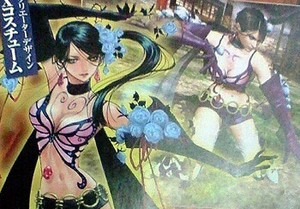 Artist Mutsumi Inomata and Namco are no strangers, as Inomata's designed characters for eight of the company's Tales RPGs, making her second only to Kosuke Fujishima in that particular series. Inomata also drew costumes for Tekken 5, and Namco seems to be making even more of her work in Tekken 6 as the game creeps toward the Xbox 360 and PlayStation 3. So far, she's contributed a butterfly halter top and matching accoutrements for Zafina, one of the newest characters in the series.
Artist Mutsumi Inomata and Namco are no strangers, as Inomata's designed characters for eight of the company's Tales RPGs, making her second only to Kosuke Fujishima in that particular series. Inomata also drew costumes for Tekken 5, and Namco seems to be making even more of her work in Tekken 6 as the game creeps toward the Xbox 360 and PlayStation 3. So far, she's contributed a butterfly halter top and matching accoutrements for Zafina, one of the newest characters in the series.
It's a long way from Inomata's work on, say, Windaria, but her Tekken art adds another manga/anime connection to the game. If Soul Calibur IV was any indication, Namco won't be stopping here. Will we see Hirohiko Araki, known for his Baoh manga's sensitive portrayals of Native Americans, draw new outfits for Julia Chang? Will Tsutomu Nihei redesign Kuma and the panda into cyberpunk killing machines? Boy, I hope so.
IN BRIEF: NARUTIMATE ACCEL 3 ANNOUNCED, BAYONETTA DELAYED
CyberConnect 2 surely breaks some hearts every time the developer announces a new game that's not Silent Bomber 2, but at least there's another Naruto fighter headed to the PSP. Narutimate Accel 3 is the sixth game in the Naruto Ultimate Ninja series (if I've got it right), and it'll apparently draw from the sixth season of Naruto Shippuden. It stands a good chance of coming here, even if Namco Bandai and Tomy are currently fond making North American Naruto releases from scratch.
Every fan of the better Devil May Cry games is anticipating Bayonetta, the 3-D action spectacle about witches and demons and derringer boots and holy shit she just body slammed a huge dragon. After all, it was created by the original Devil May Cry's director, Hideki Kamiya. They'll be anticipating it just a little longer, as the game recently slipped from this fall to January 2010 for North America. Japan, on the other hand, still gets the game in October. Some in the press suspect that Sega's doing this to give Bayonetta an uncluttered shot at the market in the post-Christmas slump, but I wonder what they'll do if a bunch of other major holiday releases suffer similar delays.
REVIEW: HOLY INVASION OF PRIVACY, BADMAN!
 Developer:Japan Studio/Acquire
Developer:Japan Studio/Acquire
Publisher: NIS America
Platform:PSP
Players: 1-4 (online)
MSRP: 19.99 (download only)
Holy Invasion of Privacy, Badman! What Did I Do to Deserve This? is hardly the first game to let players build cunning, hero-slaying dungeons. Tecmo's Deception and Bullfrog's Dungeon Keeper popularized that idea over a decade ago, after all. However, there's no other game that takes the concept and applies it so ably to a quick, dirty, and endearingly witty action game, one that's perhaps closer to old trial-and-error arcade games than forgiving modern simulations.
As an unseen instrument of godlike evil, you're tasked with digging out a subterranean maze to house an officious and apparently helpless overlord. Everything's arranged in a convenient grid, with dungeons carved out one pixelly block at a time. Some blocks are rich in monster-developing nutrients, and destroying them reveals slimes, caterpillars, lizard-warriors, and, if you're careful, dragons and summoned demons. As you chip out a labyrinth worthy of the darkest evildoers, you'll have to keep your monsters robust and active, lying in wait for bands of annoying go-gooders who trek through your creations. If you're feeling especially cruel, you can even revive the skeletal remains of former heroes to combat the newly arrived ones. Of course, you have no direct control over what the monsters do. You can only unearth them and dig new tunnels to nudge them down certain paths. You can also break out monsters while filthy adventurers are navigating your maze, though fresh-hatched creatures rarely put up a real fight.
Badman is deliberately primitive in appearance, with tiny sprites forming monsters, warriors, and even the more fearsome creatures. It all works to the game's advantage, allowing a smooth pace and crowded, slowdown-free dungeons that swarm with nutrient-spreading slimes and magic-dispersing wisps. The viewpoint can pull back to make everything even smaller, just so you can dig a dungeon faster and in the shape of whatever crude slang you prefer.

There's more to Badman than dirty dungeon design, of course. Every monster has its own movement patterns and life cycle, and most feed off each other. Slimes bloom into flowers and create other slimes, “omnom” bugs eat slimes and turn into deadly moths, lizard-folk dig burrows and lay eggs, and dragons are destructive but not terribly smart when it comes to moving around. A monster-upgrading system also comes into play, as your unused digging points go toward making better creatures. Of course, if you don't use those points to dig out enough passageways and beast burrows, it'll be all the easier for heroes to capture the overlord. That will signal the end of the game, with no continuing or restarting from a save file.
In fact, Badman holds surprisingly swift demises for the unprepared. Players have one dungeon space to tunnel out with each game, simply adding on to their work with each chapter. If your overlord is dragged up to the surface, the game gives you a final score and kicks you back to the beginning. Here's where the game's somewhat random elements frustrate. You can carefully dig out tunnels, yet you're still at the mercy of where slimes and wisps drop their powers, and you often can't get the most powerful creatures when you need them most. The opposition is always well-equipped, and once heroes start coming after your overlord in parties, you'd better have more than just a few high-level lizardmen to stand in the way. If not, you'll have to watch the alleged good guys mercilessly slaughter all of your monsters, down to the newly hatched baby lizards.

Fortunately, there's more than just a story mode. The tutorials function as a slightly more forgiving rounds of adventures, with introductory monster-raising and a series of increasingly tough goals to reach. There's also a multiplayer mode where you share dungeon designs with other players. It also helps that Badman's rapidly escalating difficulty shows off an amusing localization, littered with geeky in-jokes (“You have my fanfic!”) and cynical humor. Characters talk in deliberately garbled sounds, and the heroes' grunts of defeat are the most disturbing death-squeaks this side of Final Fantasy Tactics Advance.
Badman's greatest hurdle may be its price. It's download-only for North America, and $20 seems a bit much compared to all of the ten-dollar games floating around the PlayStation Network, Xbox Live, and WiiWare. Perhaps such costs are the way of the future, but I at least like to get a box and manual when I buy a game.
Overpriced or not, Holy Invasion of Privacy, Badman! is enjoyable, amusing, and novel in its approach (if not its main conceit). It doesn't require long-term interest or quick reflexes, and the dungeon-building lends itself well to both short bursts of score-chasing or extensively planned mazes. It's the sort of inventive pleasure needed in the game industry, and that makes it worth more than the usual cost.
RELEASES FOR THE WEEK OF 7-26
THE KING OF FIGHTERS XII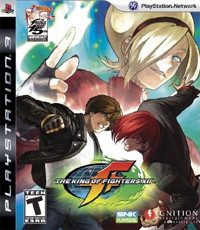 Developer: SNK
Developer: SNK Publisher: Ignition Games Platform: Xbox 360/PS3 Players: 1-2 (online) MSRP: 59.99 The King of Fighters XII is testing its fans. For eleven games and various spin-offs, the series built up dozens of characters and demanded that followers pick their favorites. Now The King of Fighters XII shows up with amazing new hand-drawn graphics and a lineup of 22 characters, in a series that normally stocks 30 fighters in each game. Among some fans, The King of Fighters XII is noted less by who's there than by who isn't: Blue Mary and Billy Kane and Maxima and Whip and Angel and K' and King and Kula and, of course, Mai Shiranui are all absent. Many of the returning characters also sport redesigns, though the only new face to The King of Fighters is Raiden, and he was in other SNK fighters before KoF ever existed. While overhauling the visuals completely, SNK sticks with the idea of three-fighter teams in The King of Fighters XII, though they've shed any pretense of lining up in the cast in squads. The major gameplay adjustment comes in the form of the Critical Counter, which lets you pull off a string of attacks after opening up your opponent's defenses. It's explained in excited SNK-style English here. That might not make up for the lack of Eiji Kisaragi or B. Jenet, but it's clear that SNK is taking The King of Fighters to slightly new ground. |
WII SPORTS RESORT Developer: Nintendo
Developer: Nintendo Publisher: Nintendo Platform: Wii Players: 1-4 MSRP: 49.99 Wii Sports is doomed to be this game generation's Super Mario Bros./Duck Hunt, a package so cheap and commonplace that some nutcase will make a suit out of unwanted copies and wear it to an anime convention. Wii Sports Resort probably won't be as frequent a sight, though it's here to promote Nintendo's improved (and packed-in) Wii Motion Plus attachment just as much as the original Sports promoted the Wii itself. To that end, Resort has twelve sports designed to show off the more accurate control of the Motion Plus, and only two of them, bowling and golf, are staples from the first game. The rest are new: Archery, Basketball, Frisbee, Wakeboarding, Cycling, Canoeing, Table Tennis, Swordplay, Powercruising (effectively jet-ski-riding), and the three modes of Air Sports. It's a fine expansion of the Wii Sports package, and it should prove just as effective at parties and family gatherings where skeptical relatives want to play that Ninten-Wii Thing. Also shipping: The regular editions of BlazBlue for the Xbox 360 and PS3, plus Marvel vs. Capcom 2 for Xbox Live. |
EXTRA LIVES: CHUBBY CHERUB
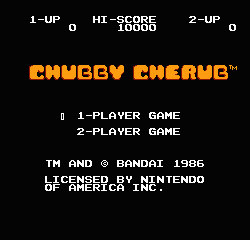 I often steer this column toward old Japanese games that had their anime affiliations censored or removed entirely when they came to North America. I've covered Spellcaster, I've covered Decapattack, and someday I'll cover Dragon Power, the Dragon Ball hack-job that turned underwear into sandwiches. For this column, however, there's no getting around it: I have to write about Chubby Cherub.
I often steer this column toward old Japanese games that had their anime affiliations censored or removed entirely when they came to North America. I've covered Spellcaster, I've covered Decapattack, and someday I'll cover Dragon Power, the Dragon Ball hack-job that turned underwear into sandwiches. For this column, however, there's no getting around it: I have to write about Chubby Cherub.
Chubby Cherub began life as Obake no Q-Taro: Wanwan Panic, an early Famicom game based on Fujiko Fujio's Obake no Q-Taro manga and its related anime series. While it's perpetually overshadowed by the Fujiko Fujio partnership's far more famous creation, Doraemon, Q-Taro endured through many volumes of manga and at least two TV series, all devoted to the misadventures of a cowardly ghost, his spirit-world allies, and his brigade of young human friends. Many of them show up in Wanwan Panic, which sends Q-Taro floating through the air, eating snacks and getting attacked by his most hated enemy: dogs.
When the Famicom came to North America as the Nintendo Entertainment System, Bandai seized the apparently plot-free Q-Taro game and slapped it with a new title screen and main character. The pale, ducklike, goggle-eyed specter of Q-Taro was out, and a tow-headed angel named Chubby Cherub was in.

Little was changed beyond that, as Chubby still wafts over trees and buildings while gobbling all sorts of food. Bandai didn't even bother replacing the rice balls and sweet dumplings-on-a-stick that Chubby often devours. After all, the NES was a new system in a country that distrusted video games, and Bandai wasn't going to try too hard for a console that might not survive test markets.
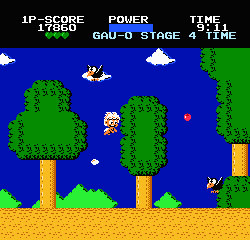 Chubby Cherub grants its hero few skills. Holding down the jump button lets him fly through the air, provided that his power meter's not empty, and upon snacking on lollipops, he'll get a limited number of hearts (know on-screen as "GAU") to throw at barking dogs and other foes. As he feeds, a “P” icon will occasionally pop up, granting him very brief bursts of invincibility.
Chubby Cherub grants its hero few skills. Holding down the jump button lets him fly through the air, provided that his power meter's not empty, and upon snacking on lollipops, he'll get a limited number of hearts (know on-screen as "GAU") to throw at barking dogs and other foes. As he feeds, a “P” icon will occasionally pop up, granting him very brief bursts of invincibility.
It's a very simple action game, though strange goals sometimes emerge. Some stages end with Chubby searching windows of buildings until he finds a kid to rescue, while the last leg of every third level trots out a bomb-hurling thug who must be defeated by being pelted with a dog's bone. Flying too far up or down can sometimes plunge Chubby into early NES visions of heaven and hell. Heaven is a place of pillowy clouds and cupcakes. Hell is a lightless maze of unceasing brutality, where Chubby is repeatedly murdered by cats and dogs as he struggles to reach the exit. Your game never ends in this stygian nightmare, for that would grant you release, and there can be no easy escape from Chubby Cherub's pit of eternal damnation.
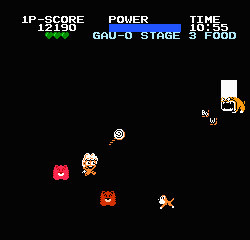 I can say with certainly that I hate Chubby Cherub and the game he drives. I hate his vacant expressions. I hate the way he apparently farts out hearts at his enemies. I hate the grating music and the bland graphics. I hate how the hit detection is awful except when a dog is barking sound effects at you with pinpoint accuracy. I hate knowing that, despite its relatively limited production run, Chubby Cherub was still purchased and given to children who thought themselves lucky to own an NES in 1986. Like countless old video games, Chubby Cherub is hard in the laziest possible way, with no continues and a hero that can take one hit before dying. The levels are repetitive, and there isn't even an ending for those who suffer through a dozen of them.
I can say with certainly that I hate Chubby Cherub and the game he drives. I hate his vacant expressions. I hate the way he apparently farts out hearts at his enemies. I hate the grating music and the bland graphics. I hate how the hit detection is awful except when a dog is barking sound effects at you with pinpoint accuracy. I hate knowing that, despite its relatively limited production run, Chubby Cherub was still purchased and given to children who thought themselves lucky to own an NES in 1986. Like countless old video games, Chubby Cherub is hard in the laziest possible way, with no continues and a hero that can take one hit before dying. The levels are repetitive, and there isn't even an ending for those who suffer through a dozen of them.
Clues point to Chubby Cherub and Obake no Q-Taro being the work of TOSE, the prolific developer that guarded its projects closely for many, many years. They're connected to a bunch of Bandai games rooted in anime licenses, though they downplay this history in favor of focusing on current TOSE titles, which include the Starfy series. I can see why a company wouldn't own up to making Chubby Cherub.
Chubby Cherub is among the more obscure early releases for the NES, which has led some collectors to assume that it's rare and valuable. Fortunately, no one actually wants Chubby Cherub to play it, so it goes for about $10 among those building libraries of every NES game.
discuss this in the forum (13 posts) |
this article has been modified since it was originally posted; see change history